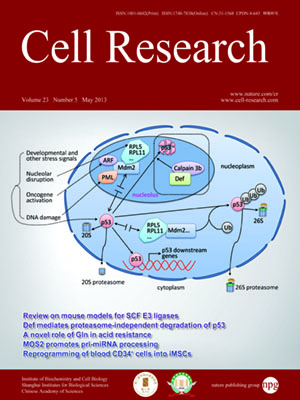
Volume 23, No 5, May 2013
ISSN: 1001-0602
EISSN: 1748-7838 2018
impact factor 17.848*
(Clarivate Analytics, 2019)
Volume 23 Issue 5, May 2013: 705-719
ORIGINAL ARTICLES
Single strand DNA binding proteins 1 and 2 protect newly replicated telomeres
Peili Gu1, Wei Deng2,3, Ming Lei2,3 and Sandy Chang1
1Department of Laboratory Medicine and Pathology, Yale University School of Medicine, 330 Cedar St., New Haven, CT 06520, USA
2State Key Laboratory of Molecular Biology, Institute of Biochemistry and Cell Biology, Shanghai Institutes for Biological Sciences, Chinese Academy of Sciences, 320 Yueyang Road, Shanghai 200031, China
3National Center for Protein Science Shanghai, 320 Yueyang Road, Shanghai 200031, China
Correspondence: Sandy Chang,(s.chang@yale.edu)
Human single-strand (ss) DNA binding proteins 1 and 2 (hSSB1 and 2) are components of the hSSB1/2-INTS3-C9orf80 heterotrimeric protein complex shown to participate in DNA damage response and maintenance of genome stability. However, their roles at telomeres remain unknown. Here, we generated murine SSB1 conditional knockout mice and cells and found that mSSB1 plays a critical role in telomere end protection. Both mSSB1 and mSSB2 localize to a subset of telomeres and are required to repair TRF2-deficient telomeres. Deletion of mSSB1 resulted in increased chromatid-type fusions involving both leading- and lagging-strand telomeric DNA, suggesting that it is required for the protection of G-overhangs. mSSB1's interaction with INTS3 is required for its localization to damaged DNA. mSSB1 interacts with Pot1a, but not Pot1b, and its association with telomeric ssDNA requires Pot1a. mSSB1Δ/Δ mice die at birth with developmental abnormalities, while mice with the hypomorphic mSSB1F/F allele are born alive and display increased sensitivity to ionizing radiation (IR). Our results suggest that mSSB1 is required to maintain genome stability, and document a previously unrecognized role for mSSB1/2 in the protection of newly replicated leading- and lagging-strand telomeres.
Cell Research (2013) 23:705–719. doi:10.1038/cr.2013.31; published online 5 March 2013
FULL TEXT | PDF
Browse 2385


